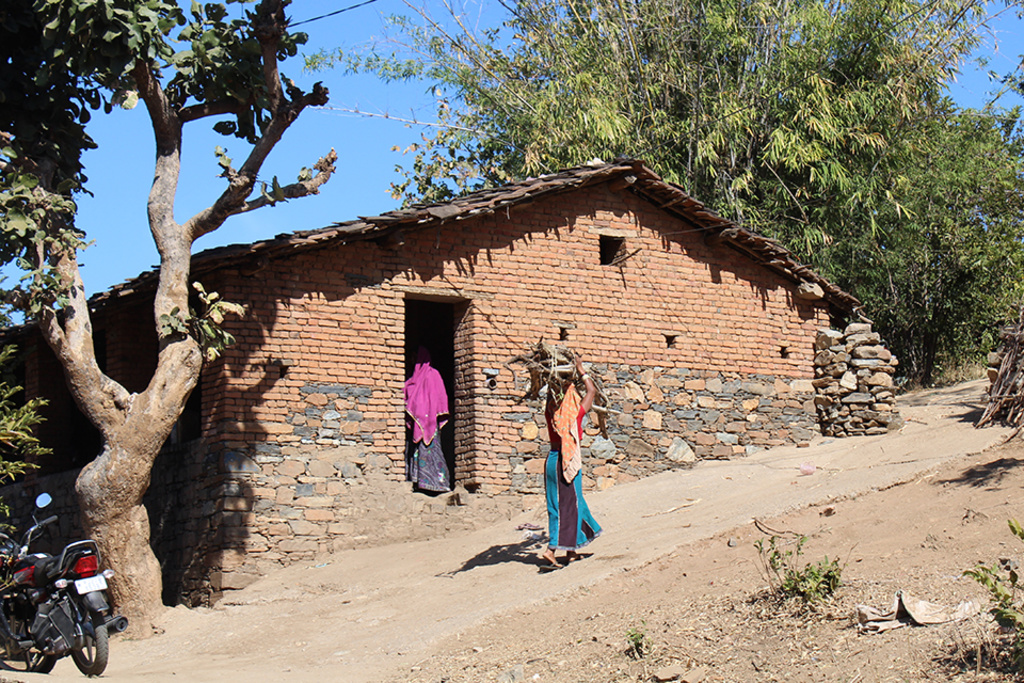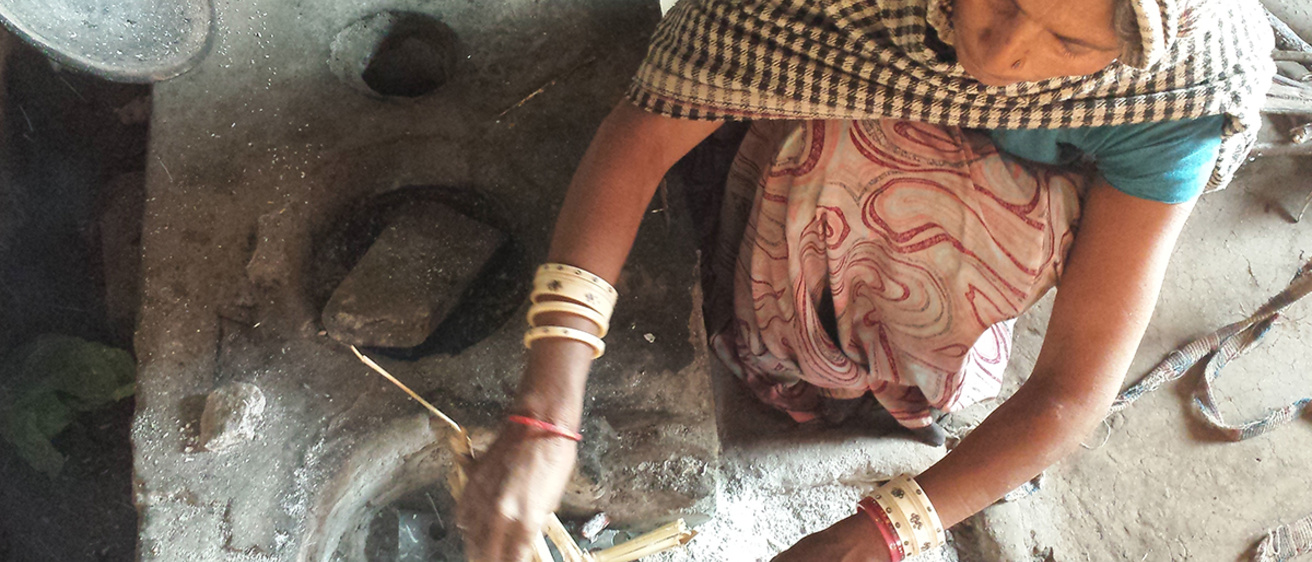Millions of women around the world die every year from the simple household task of cooking. The smoke from the biomass, often wood, that is burned to heat their pots, pans, and griddles for cooking food is hazardous to health and often deadly. From April 12–14, the University of Iowa will host a group of internationally recognized experts at a conference, Women’s Health and the Environment: Going up in Smoke, to address this silent global crisis.
Conference organizer Jerry Anthony, UI professor of urban and regional planning, recently published an overview of the cookstove issue in World Development.
Read more about the April 12–14 conference.
According to the United Nations and Global Alliance for Clean Cookstoves, about 2.7 billion people around the world cook their food on a cookstove or open fire by burning some form of biomass, such as wood. The World Health Organization estimates that the carbon dioxide, carbon monoxide, and other pollutants released while burning biomass lead to 4 million deaths annually.
“The number of people who are dying every year from just cooking for their families is staggering,” says conference organizer Jerry Anthony, UI professor of urban and regional planning. “Even in developing countries where this is such a problem, there is very little media discussion about this issue because these deaths are spread out over the year and therefore not sensational. It’s what Rob Nixon, a professor at Princeton, calls a ‘slow violence.’”
Anthony is a member of a multidisciplinary research team formed by H.S. Udaykumar, UI professor of mechanical engineering, that is tackling this problem and achieving success in a field often mired in failure. Along with UI colleagues Meena Khandelwal, Matthew Hill, and Marc Linderman, Anthony and Udaykumar teach a Big Ideas course that grew out of their research, a course that has become a model for other interdisciplinary classes at the UI.
Iowa Now reported on the research team’s efforts in 2015 and talked to Anthony to learn more about the conference and get an update on the team’s efforts.
The conference you’re organizing is about wood-burning cookstoves, household air pollution, and their effects on both public health and on the environment. Can you describe these cookstoves and tell us who is affected by these issues?
It’s a very large population that is using these cookstoves, including millions of families in Central America and the majority of families in Africa and Asia.
Sometimes these cookstoves are nothing but two stones on which a pot is placed, a fire is lit under that, and wood is burned. Sometimes it is three stones. Sometimes it might be covered over by some kind of mud plaster to make it into a more formal stove. Sometimes it’s a metal sort of device into which you put wood.
Cookstoves will be displayed on the T. Anne Cleary Walkway from 2:30 to 4:30 p.m. April 12 to show how billions of people around the world cook their food.
To use these cookstoves, people cut down trees, which leads to deforestation, and as human population increases, the deforestation increases. The year-to-year rate of deforestation is not alarming, but decade to decade it is shocking.
But perhaps the most profound impact is on women’s health—it is mostly the women in the household who are actually cooking with these stoves. The average woman in this situation is cooking two, maybe three meals a day for her family of five or six. They don’t have any other options. They are engaging in a completely benign and necessary activity and they get exposed to all kinds of chemicals released from burning wood.

According to health experts, cooking in this way is the equivalent of smoking 20 cigarettes a day. And often younger women have a baby on their lap or in their arms as they’re cooking, and these babies are being exposed.
These cookstoves are killing millions of women and children while also negatively impacting the environment.
Your research has taken you into the homes of many people who use these cookstoves. Can you describe what these homes are like and the lives of people living and cooking in them?
At this point, our research team has gone primarily into homes in Rajasthan in northwestern India. These families live in bona fide rural areas, eking out a subsistence existence, a hand-to-mouth existence. They have small land holdings where they cultivate food crops, usually just enough for themselves with no surplus to sell or trade. Their homes are often made of stone or mud and sometimes of brick with mud mortar. They are often single-room homes with maybe tree branches to serve as rafters, and slate or sometimes just mats of woven leaves for a roof.
Girls, when they are maybe 10 or 12, start going out with their mothers to collect wood from miles away. They gather and carry bundles of wood that are at the very minimum 40 to 50 pounds, and they carry them back on their heads. At the villages that we visited, the women in the household go on a wood collection walk twice or thrice a week, taking an hour and a half each way to the forest.
You are part of a research team that has been trying to solve this problem. Can you explain what you and your team have done and how it differs from other researchers?
Frankly, a lot of research has gone into improving and disseminating cookstoves since organizations and governments began paying attention to this issue in the 1930s and ’40s. But success has been very limited.
The first reason for this is that any kind of intervention that requires people to cook in a new or different manner is virtually impossible to implement successfully. Food is so critical to a people’s cultural identity, daily life, and psyche. It’s very difficult to go to people and say, ‘You know what? You should not be eating X because this is bad for the environment and you should now eat Y.’ It just doesn’t work.
For example, five years ago, the NGO (non-governmental organization) that we work with tried disseminating solar cookstoves in an area of India that is blessed with sunshine. They went back a year later to see how people were using them and found that none were. The problem was that the solar cookstove could generate temperatures of about 200 to 250 degrees Fahrenheit, but the bread that the people ate needed temperatures of about 300 degrees Fahrenheit to bake. They couldn’t make bread with the solar cookers.
But even if they could make bread with the cookstove, the solar cooker could only work when there’s high sun. Those people cooked early in the morning and late in afternoon when there was much less sunshine. To use a solar cooker, they would have had to change when they cooked and ate their meals.
The other problems that have arisen are cost, durability, and price. The cookstove itself must be affordable. If you have something that costs even $30 or $40, it’s beyond the reach of the people in these villages. And if a new cookstove breaks down a lot or costs a lot to fix, it’s not going to be used.
We really need something that is very low cost, does not change people’s cooking habits, is durable, and if broken can be fixed easily. That’s where our research has concentrated, and that’s what we feel we have produced.
Udaykumar and his students have designed an insert, made of iron, no bigger than three smart phones stacked on top of each other, that can be placed in a traditional cookstove below the firewood. The insert has been carefully designed using complex models of combustion and airflow. And it doesn’t require anyone to change what they are cooking, when they cook, or what they use to cook.
In lab tests, Udaykumar found that this insert reduces smoke by 70 percent and firewood consumption by 30 to 40 percent. And it costs 80 cents to manufacture in India.
We gave about 2,000 of these inserts to families in Rajasthan in 2015, and as of this last winter when we visited these families again, about 60 percent were still using them, which tells us they are probably very durable.
We say 60 percent, a conservative estimate, because even 60 percent is astonishingly high compared to other efforts. This is very promising, but more work is needed before we can start affecting widespread change.
Why host a conference like this? Can you give some highlights you expect from the conference?
We want this to be a conference where researchers can learn from practitioners out in the field and vice versa, so we have invited both. We want this to be a place where lots of cross-pollination happens.
We are absolutely thrilled with the people who accepted our invitation.
The keynote speakers include Kirk Smith, a professor at the University of California, Berkeley, and a key member of the Intergovernmental Panel on Climate Change, which won the Nobel Peace Prize in 2007. He has been researching cookstoves for about 40 years and is an eminent researcher in this field.
Another keynote speaker is Gautam Yadama, the assistant vice chancellor for international affairs and dean of Boston College’s School of Social Work. He has looked at health impacts of various policies on women and marginalized people across the globe, and he’s an internationally recognized expert on this topic.
In addition to the cross-pollination of ideas, we want to come up with two or three key new ideas for policy interventions. We’re hoping that we will have new ideas on what kinds of cookstoves should be built, how to distribute them, and how to create grassroots market awareness so they take off without many subsidies from governments in communities across the globe.
What’s next for your research team?
The next big challenge is to help create a market for our insert—but first we want to do a very thorough study to actually confirm the high adoption rate. Then we want to find out why 40 percent didn’t use the insert and make adjustments if necessary.
We feel that it shouldn’t be nonprofits handing out this insert. It should be something that people desire to buy and then go and spend a dollar to buy it. That way, it’s an organic process that just takes off.
These women around the globe are experiencing breathing and eye problems. They know that cooking with wood is a problem and that it is slowly poisoning them. We want them to know that there’s an affordable, low-hassle solution for it, and that awareness is what we need to create.
